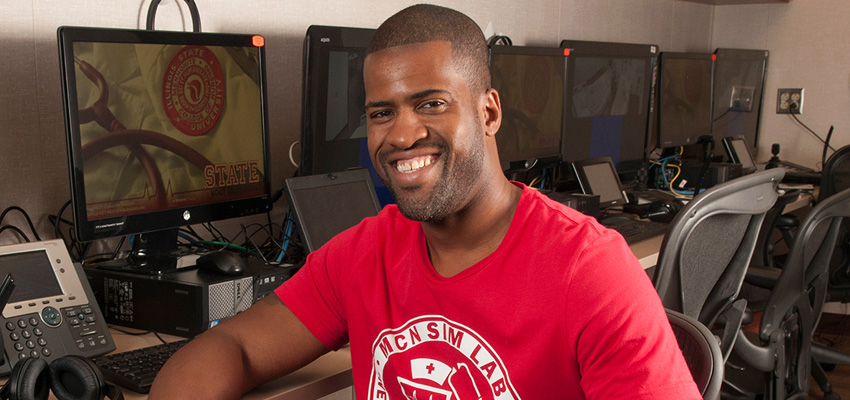For someone with degrees in history and arts technology, Isaac Akins knows an awful lot about nursing.
“My colleagues joke that I should get an honorary nursing degree,” said Akins, associate director of technology for Mennonite College of Nursing at Illinois State University. Though the first to admit he’s not ready to practice medicine, Akins is very good at helping Mennonite students hone their nursing skills.
Akins is in charge of the technical operations of Mennonite’s Nursing Simulation Laboratory that provides realistic, hands-on training on a wide array of clinical skills, from taking a patient’s pulse, to giving injections, to responding to complex medical emergencies such as seizures or cardiac arrest.
Akins’ career path has taken interesting turns. While studying African and African-American history as an undergraduate, he worked as a graphic designer and art director at Illinois State’s student newspaper, The Vidette. That experience led him to the arts technology program in the College of Fine Arts, where he studied audio-visual development and web design. After working as a designer at The Pantagraph, he was hired at Mennonite to help develop online learning modules for the college. His job duties expanded to that of an IT associate and before long he was tapped to work with the college’s growing array of clinical simulation technology.
“At first I didn’t know exactly what I was jumping into,” said Akins, who went through extensive training and soon mastered the operation of the simulation technology. “Dean Janet Krejci came to me one day and asked me to be a part of the team working on a vision for an expanded simulation lab. She asked us to ‘think big’ and include the kinds of technology and facilities that would provide a first-rate educational experience.”
That vision process eventually led to the development of the Nursing Simulation Laboratory. Akins was instrumental in working with architects to develop the layout of the lab and in choosing the technology to be included in it. The most sophisticated pieces of equipment in the lab are the patient simulator mannequins, which are operated from a separate control room during clinical training scenarios. The mannequins may be machines, but Akins says students quickly learn to treat them like real people.
“Training scenarios in the lab can be pretty stressful due to the realism,” he said. “Students become mentally and emotionally involved in the simulations with the mannequins. Within the first five minutes, it stops being a mannequin and becomes a real person in a real life situation.”
Akins says some of the most stressful clinical scenarios involve medical issues with small children or babies, and issues about the proper dosage of medication, something that can have serious implications if done wrong. Mastering skills in the lab prepares students well for clinical experiences in other areas, such as hospitals.
“The lab is the place to make mistakes so that they won’t be repeated in a real situation,” said Akins. “These simulations train nurses to be safe and encourage a holistic approach. They are dealing not only with patients, but with other medical staff as well as with family members.”
Akins’ knowledge about technology in the labs is well-recognized and appreciated among the faculty, staff and students in Mennonite College of Nursing. He has also been able to share that expertise with others across the country. In 2012 he gave a presentation about the development of Mennonite’s simulation lab to a conference sponsored by Education Management Solutions (EMS), a clinical simulation software development company. This past January he was honored by that company as a Simulation Champion for his expertise in using technology in nursing education.
Akins really enjoys working in the current lab, but he is always looking to the future and knows that technology will play an even greater role in nursing education. “Technology is constantly changing and nursing simulation is still in the toddler stage,” he said. “There is a lot more growth out there.”

